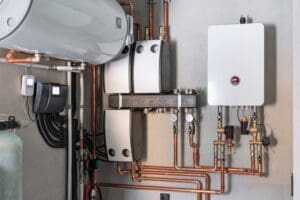How Much Does It Cost to Replace a Back Boiler?


If you live in an older home, chances are you’ve heard of a back boiler. These were popular heating systems installed behind fireplaces. They provided hot water and heating by burning gas or solid fuel. But today, back boilers are outdated, inefficient, and even unsafe.
So, if you still have one, you might be thinking about replacing it. But how much does it cost to replace a back boiler? The answer isn’t simple. Several factors affect the total price, such as the new system you choose, the condition of your current system, and the size of your home.
In this guide, we’ll break it all down for you. You’ll learn what back boilers are, why they need replacing, and the full cost involved. We’ll also help you understand your options and what to expect during the process.
What Is a Back Boiler?
A back boiler is a small boiler unit that sits behind a fireplace or stove. It heats water for radiators and taps. It became popular in the UK in the 1960s and 70s.
These boilers worked well at the time. But over the years, they’ve proven to be less energy-efficient and harder to maintain than modern systems. Many back boilers are no longer supported or are illegal to repair due to safety rules.
Why Should You Replace a Back Boiler?
Here are the main reasons people go for a back boiler replacement grant:
1. Low Efficiency
Back boilers usually have an energy efficiency rating of around 70%. In comparison, modern condensing boilers can reach over 90%. That means you’re likely wasting energy and paying higher bills with a back boiler.
2. Safety Risks
Some old back boilers, especially the Baxi Bermuda models, were found to be dangerous if not properly maintained. Cracks and leaks can lead to carbon monoxide leaks. Many models are now banned or discontinued.
3. Repair Problems
Replacement parts are hard to find. Skilled engineers who can work on back boilers are also rare. Most professionals recommend removing them altogether.
4. Legal & Compliance Issues
Current building regulations make it almost impossible to fit a new back boiler. If you plan on selling or renting your home, you may have to replace the old system to meet the standards.
What Are the Back Boiler Replacement Options?
When replacing a back boiler, you have three main options. Each one affects the total cost.
1. Combi Boiler
A combi (combination) boiler is the most popular option. It heats water on demand and doesn’t require a hot water cylinder or storage tank. It’s compact and ideal for smaller homes.
Pros:
- Saves space
- Lower running costs
- Energy-efficient
Cons:
- May struggle with high hot water demand
2. System Boiler
A system boiler needs a separate hot water cylinder but no cold-water tank. It works well in larger homes where hot water is needed in multiple places at once.
Pros:
- Good for homes with multiple bathrooms
- Works well with solar panels
Cons:
- Takes more space than a combi boiler
3. Regular or Heat-Only Boiler
This is the closest match to your back boiler setup. It uses a hot water cylinder and a cold-water tank. If your house already has this system, it may be cheaper to upgrade this way.
Pros:
- Keeps the same layout
- Ideal for older properties
Cons:
- Less efficient than modern combi boilers
Cost of Back Boiler Replacement
Let’s get to the big question: How much does it cost to replace a back boiler? Here’s a breakdown of all the costs involved.
1. Boiler Unit Cost
- Combi Boiler: £1,500 – £2,500
- System Boiler: £1,600 – £2,700
- Regular Boiler: £1,400 – £2,500
The price depends on the brand, size, and energy rating. Popular brands like Worcester Bosch, Vaillant, and Ideal may cost more but come with longer warranties.
2. Installation Cost
The installation work is often the biggest part of the total cost. A back boiler replacement is not a simple switch. It requires:
- Removing the old back boiler
- Changing the pipework
- Installing the new boiler elsewhere
- Sealing off or removing the fireplace
- Fixing walls and redecorating
Expect to pay between £2,000 – £3,000 for installation alone.
3. Additional Parts & Labour
You may also need extra materials like:
- New flue or plume kit: £100 – £300
- New controls or smart thermostat: £100 – £250
- Magnetic filter: £100 – £150
- Power flush of the system: £300 – £600
Labour and time will also increase if your home has difficult access, outdated pipework, or if you’re moving the boiler far from the original spot.
Total Estimated Cost
Let’s put it all together.
| Option | Boiler + Install + Extras |
| Combi Boiler | £3,500 – £5,000 |
| System Boiler | £3,800 – £5,500 |
| Regular Boiler | £3,400 – £5,000 |
These are ballpark figures for a standard 2–3 bedroom home in the UK. The final cost depends on your property, location, and choice of boiler.
How Long Does It Take to Replace a Back Boiler?
Most back boiler replacement jobs take 3 to 5 days. Here’s why:
- Day 1–2: Removing the old boiler and fireplace work
- Day 3–4: Installing the new boiler and connecting new pipes
- Day 5: Testing, power flushing, and final checks
If there are complications, it may take longer. But a trained engineer can give a clearer time estimate after inspecting your home.
Can I Get Help with the Cost?
Yes! Several UK schemes can help with the cost of back boiler replacement:
1. Boiler Upgrade Scheme (BUS)
This helps homeowners switch to low-carbon heating. You could get up to £7,500 for replacing your boiler with a heat pump or renewable system.
2. ECO4 Scheme
If you’re on certain benefits, you may qualify for a free boiler replacement under the Energy Company Obligation scheme. This includes removing back boilers in some cases.
3. Finance Options
Many boiler companies offer payment plans or 0% finance. This can help you spread the cost over 2 to 10 years.
What Happens to the Fireplace?
Since back boilers sit behind fireplaces, you’ll have to deal with the space they leave behind. You have several options:
- Block it off completely and plaster over it
- Install an electric fire for decoration
- Add a cupboard or feature wall
Some homeowners even choose to install a wood-burning stove in the space. Just make sure your installer seals off the chimney properly to avoid draughts or safety issues.
Do I Need Planning Permission?
In most cases, you don’t need planning permission for a back boiler replacement. However:
- If your home is listed or in a conservation area, check with your local authority
- You’ll need a Gas Safe-registered engineer for any gas work
- Building regulations apply to all boiler installations
Always make sure your installer provides a Building Regulations Compliance Certificate after the job is done.
Common Questions About Back Boiler Replacement
Q: Can I repair my old back boiler instead of replacing it?
A: In most cases, no. Replacement parts are rare, and many back boilers are no longer legal to repair.
Q: Is it cheaper to keep my hot water tank?
A: Sometimes. If you choose a system or regular boiler, you can use your current tank. But if it’s old, replacing it may still be best.
Q: What’s the best boiler for replacing a back boiler?
A: For smaller homes, a combi boiler is ideal. For larger homes, a system boiler may be better.
Final Thoughts
Replacing a back boiler is a big job. But it’s often necessary for safety, efficiency, and comfort. While it may cost between £3,500 and £5,500, the long-term savings on your energy bills make it worth it.
Choosing the right system depends on your home’s size, layout, and hot water needs. A registered installer can help you pick the best option and handle the process safely.
Whether you go for a combi, system, or regular boiler, make sure to compare prices, ask for warranties, and check if you qualify for any Eco4 Scheme grants.
Back boiler replacement might seem costly up front, but it’s a smart move for a warmer, safer, and more efficient home.







